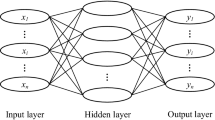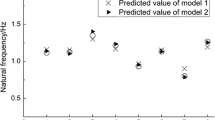Abstract
The study of mooring forces is an important issue in marine engineering and offshore structures. Although being widely applied in mooring system, numerical simulations suffer from difficulties in their multivariate and nonlinear modeling. Data-driven model is employed in this paper to predict the mooring forces in different lines, which is a new attempt to study the mooring forces. The height and period of regular wave, length of berth, ship load, draft and rolling period are considered as potential influencing factors. Input variables are determined using mutual information (MI) and principal component analysis (PCA), and imported to an artificial neural network (NN) model for prediction. With study case of 200 and 300 thousand tons ships experimental data obtained in Dalian University of Technology, MI is found to be more appropriate to provide effective input variables than PCA. Although the three factors regarding ship characteristics are highly correlated, it is recommended to input all of them to the NN model. The accuracy of predicting aft spring line force attains as high as 91.2%. The present paper demonstrates the feasibility of MI-NN model in mapping the mooring forces and their influencing factors.
Similar content being viewed by others
References
Ahmed, M.O., Yenduri, A. and Kurian, V.J., 2015. Investigation on the dynamic responses of a truss spar platform for different mooring line groups, Journal of Marine Science and Application, 14(2), 189–195.
Bowden, G.J., Dandy, G.C. and Maier, H.R., 2005. Input determination for neural network models in water resources applications. Part 1-background and methodology, Journal of Hydrology, 301(1–4), 75–92.
BSI, 1994. Maritime Structures-Code of Practice for Design of Tendering and Mooring Systems, BS 6349-4-1994, BSI, UK.
Chu, X.J., Sheng, D. and Zhao, X.Z., 2014. Prediction of the mooring force of a 2-D floating oil storage tank, Journal of Ocean University of China, 13(6), 901–910.
Cornett, A., 2014. Physical modelling of moored ships for optimized design of ports and marine terminals, Proceedings of the 5th International Conference on Physical Modeling in Coastal and Port Engineering, Varna, Bulgaria.
Cui, H.Y., Zhao, D.Y. and Zhou, P., 2009. Adaptive predictive inverse control of offshore jacket platform based on rough neural network, China Ocean Engineering, 23(2), 185–198.
Fraser, A.M. and Swinney, H.L., 1986. Independent coordinates for strange attractors from mutual information, Physical Review A, 33(2), 1134–1140.
Gao, P.Y., Jiang, C., Huang, Q., Cai, H., Luo, Z.F. and Liu, M.J., 2016. Fluvial facies reservoir productivity prediction method based on principal component analysis and artificial neural network, Petroleum, 2(1), 49–53.
Hotelling, H., 1933. Analysis of a complex of statistical variables into principal components, Journal of Educational Psychology, 24(6), 417–441.
Jiang, Q., Ge, H.Z. and Xie, P., 2007. Influence of ship’s type and tonnage on the ship’s mooring force, Port & Waterway Engineering, (9), 51–59. (in Chinese)
Karunanithi, N., Grenney, W.J., Whitley, D. and Bovee, K., 1994. Neural networks for river flow prediction, Journal of Computing in Civil Engineering, 8(2), 201–220.
Li, S.F. and Qiu, Z.Z., 2017. Modeling and simulation of mooring force prediction based on improved GA-BP network, Journal of System Simulation, 29(7), 1457–1463. (in Chinese)
Liu, B.J., Sun, Z.C., Zhang, Z.M. and Yang, G.P., 2008. On movement of moored ships at large open terminal under transverse wave, Port & Waterway Engineering, (8), 94–97. (in Chinese)
Lu, X.W., Sun, Z.C., Zhang, Z.M. and Yang, G.P., 2009. Model test study on optimizing length of island berth in open water area, Port & Waterway Engineering, (12), 82–86. (in Chinese)
MOT (Ministry of Transport), 2000. Design and Construction Technical Code of Open Sea Terminal, JTJ 295–2000, Ministry of Transport of the People’s Republic of China, China Communication Press, China. (in Chinese)
Pinto, F.T., Gomes, F.V., Santos, P.R., Soares, C.G., Fonseca, N., Santos, J.A., Moreira, A.P., Costa, P. and Dias, E.B., 2008. Analysis of the behavior of moored tankers, Proceedings of the ASME 2008 27th International Conference on Offshore Mechanics and Arctic Engineering, ASME, Estoril, Portugal.
Rosa-Santos, P., Taveira-Pinto, F. and Veloso-Gomes, F., 2014. Experimental evaluation of the tension mooring effect on the response of moored ships, Coastal Engineering, 85, 60–71.
Sande, J., Figuero, A., Tarrío-Saavedra, J., Peña, E., Alvarellos, A. and Rabuñal, J.R., 2019. Application of an analytic methodology to estimate the movements of moored vessels based on forecast data, Water, 11(9), 1841.
Simoes, M.G., Tiquilloca, J.L.M. and Morishita, H.M., 2002. Neural-network-based prediction of mooring forces in floating production storage and offloading systems, IEEE Transactions on Industry Applications, 38(2), 457–466.
Thirumalaiah, K. and Deo, M.C., 1998. River stage forecasting using artificial neural networks, Journal of Hydrologic Engineering, 3(1), 26–32.
Wang, J.H. and Wan, D.C., 2015. Dynamic coupling analysis of the mooring system and floating pier in the South China Sea, Journal of Hydrodynamics, 30(2), 180–186. (in Chinese)
Wang, P., Jin, C. and Ge, H.H., 2012. Mutual information-based feature selection approach for software defect prediction, Journal of Computer Applications, 32(6), 1738–1740. (in Chinese)
Xiang, Y. and Tan, J.H., 2001. Application of monte carlo method in determination of mooring lines forces, Journal of Shanghai Jiaotong University, 35(4), 548–551. (in Chinese)
Xiang, Y., Yang, J.M., Tan, J.H. and Zhang, C.Y., 2001. Model experiment of ship moored at berth, The Ocean Engineering, 19(2), 45–49. (in Chinese)
Yang, M.R. and Zhang, X., 2016. Port mooring load prediction based on neural networks with the wavelet analysis, International Journal of Hybrid Information Technology, 9(3), 23–30.
Author information
Authors and Affiliations
Corresponding author
Additional information
Foundation item: This work was financially supported by “Demonstration Project of Innovation and Development of Marine Economy in Fuzhou in the 13th Five-Year Plan (Grant No. FZHJ16)”, “2019 Subsidy Fund Project for Marine Economy Development in Fujian Province (Grant No. FJHJF-L-2019-8)”, and Basic Scientific Research Operating Expenses of Central Public Welfare Research Institutes (Grant No. TKS170106).
Rights and permissions
About this article
Cite this article
Liu, Bj., Chen, Xy., Zhang, Yq. et al. Influence of Regular Wave and Ship Characteristics on Mooring Force Prediction by Data-Driven Model. China Ocean Eng 34, 589–596 (2020). https://doi.org/10.1007/s13344-020-0053-1
Received:
Revised:
Accepted:
Published:
Issue Date:
DOI: https://doi.org/10.1007/s13344-020-0053-1




